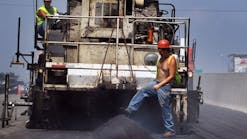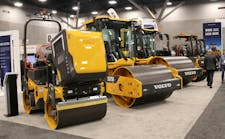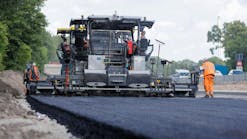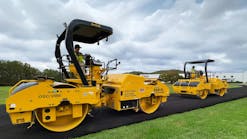“When people drive by the site every day and don't realize what's here, we know we have done our job,” remarked Jonathon Spence, city planner in Steamboat Springs, CO.
Spence is talking about the two ready-mixed concrete plants operated by Trans-Colorado Concrete and by Lafarge that sit on the west side of Steamboat Springs, just inside city limits.
The new look in ready-mixed plants started after TCC experienced a fire in 2000. After the fire, owner Pete Lien and Sons fixed the plant so they could keep batching. Then Fox Construction of Steamboat Springs came in to tear down and remodel the plant between January and April in 2002. The remodeled plant has a capacity of 140 cubic yards per hour.
“It's totally enclosed,” explained Les Sharp, plant supervisor. “Up here in this weather, that is what you do, plus in Steamboat we want to fit into a smaller community.”
All water is controlled so none washes any concrete off the site. The TCC plant has ponds for process water, which is recycled and used for washing out the trucks. The storm water is diverted off around the backside of the property so it doesn't mix with process water. When TCC ends up with too much water in the process ponds, one of the operators fills the truck with water and takes the water out to the pit of the aggregate supplier, Precision Excavating of Hayden, near Milner to empty it. Some of the waste concrete is formed into landscape blocks. Other leftover concrete is delivered to Precision, where it is crushed for recycling.
New Lafarge PlantWhen the Lafarge Western U.S. Region Aggregates & Concrete Division leased land next to TCC, the city planning department told Lafarge it wanted an attractive building like the plant next door, which didn't look like a typical ready-mixed plant. Therefore, Lafarge designed an enclosure to mask the structure of the plant as well as to contain any nuisance dust. The roof line features several offsets to break up a continuous ridge, and 10 windows break up the larger wall sections' appearance. Eight windows measure 4 feet by 6 feet, and two are 6 feet by 8 feet. Lafarge, acting as general contractor, broke ground Oct. 1, 2007, and completed the plant May 15, 2008.
“Lafarge has a commitment to safety as a No. 1 priority,” explained John Moffitt, P.E., plant designer. Therefore the plant design minimizes falling and tripping hazards. Platforms and catwalks access all areas that require plant maintenance. To prevent falls, a snowmelt system – similar to the radiant heat in the floor of the plant – warms the outside concrete areas where drivers unload trucks. All electrical gear is labeled and designed with proper equipment for quick and easy lock-out, tag-out, try-out procedure.
“Lafarge also has a strong commitment to our environment,” Moffitt added. The design separates process water from storm water by elevating the washout basins where the trucks rinse out the drums. All process water is confined to a grey water wash out system. This grey water is stored in concrete containment basins where it can be recycled to wash out trucks and be used in concrete production.
A 6,000-square-foot engineered sand infiltration basin, designed to contain a 100-year flood event, collects storm water so it doesn't wash off the site into the river. From this basin the storm water percolates into the soil. While such a basin is typical for large box store urban construction, it's not as common to a ready-mixed plant, according to Moffitt. Another environmental feature is the yard paving. The 8-inch-thick pavement prevents tracking materials onto the street and keeps the dust level down.
Keeping concrete warm in the winter is always a challenge, according to Wendy Werpetinski, communications manager. At this plant, a 100,000-BTU natural gas boiler heats a glycol solution that circulates through a grid of half-inch PEX tubing in the concrete floor, keeping plant equipment warm. Additionally, a 98-percent-efficient direct-fired natural gas heater warms the water for concrete production.
“The project turned out well and was relatively easy in going through the permitting process,” Spence concluded.
Steamboat has seen steady construction growth in the past few years and is poised for dramatic new development at the base area. Two projects are permitted and a few more are in the pipeline, according to Spence. The demand for concrete will remain strong, as will the ability of TCC and Lafarge to supply it.




